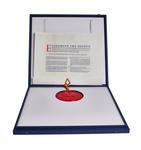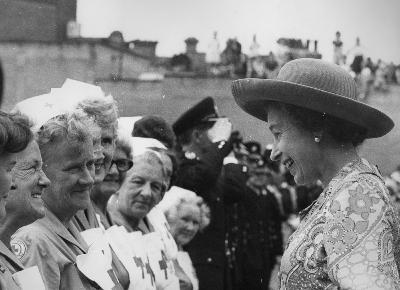The British Red Cross Royal Charter granted by Her Majesty Queen Elizabeth II.
Production date
1998
Audio tour
See full details
Details
Description
The Charter came into effect 90 years after the original one in 1908. The present Charter superseded the original and other documents such as the supplemental charters of 1919, 1955 and 1970.
It is evident from a cursory read that a primary aim of the 1998 edition was centralisation. Specifically, this affected aspects such as branches and the processing of donations. The period in which each of the charters has been conceived and developed has had its own specific attributes. The 1998 Charter was the first and indeed the only one so far to coincide with the existence of the World Wide Web, created in 1989.
Google started in 1998, several months after the latest British Red Cross Charter. So it is no surprise that then the British Red Cross was in the process of establishing its online presence, in the context of impending massive growth of the footprint of the internet globally. Since then of course great changes have taken place in a short time. This is even true of the time since 2003, when the Charter was revised. The potential for the cultural and practical impact of the British Red Cross’ website has greatly increased with the spread of internet capable mobiles, for example. The use of the internet since 1998 is a microcosm of the overall development of the Society throughout its history, present and hopefully long future.
21 years have passed since the Charter came into effect. This is similar to the gap from the creation of a set of rules for the organisation and management of the society in 1976 until the Royal approval of the current Charter in 1997.
Therefore, it is clear from the history of the Charters and the other additions that the present Charter is but the latest incarnation of the governing document for the Society. In this I can discern both a symbolic and practical demonstration of two elements at the heart of the British Red Cross: tradition and flexibility. The latter is important because it is precisely the ability to flexibly evolve to suit the changing conditions in war and peace, at home and abroad which allows the Society to best meet the original core aims. Even before the 1908 Royal Charter, it was declared when the National Society was set up in 1870 that it would, with caveats, ensure “that the aid be given impartially between the sick and wounded of the belligerent Armies.”
In other words, I think the current Charter is a blueprint for not only past and present work but also a basis for evolution well into the future as the timeless aims of the Society continue to be the focus. The structure may change, but the basic aims have not.
Audio recording by Stuart Thompson/Michael Simkins (Volunteer), London.
It is evident from a cursory read that a primary aim of the 1998 edition was centralisation. Specifically, this affected aspects such as branches and the processing of donations. The period in which each of the charters has been conceived and developed has had its own specific attributes. The 1998 Charter was the first and indeed the only one so far to coincide with the existence of the World Wide Web, created in 1989.
Google started in 1998, several months after the latest British Red Cross Charter. So it is no surprise that then the British Red Cross was in the process of establishing its online presence, in the context of impending massive growth of the footprint of the internet globally. Since then of course great changes have taken place in a short time. This is even true of the time since 2003, when the Charter was revised. The potential for the cultural and practical impact of the British Red Cross’ website has greatly increased with the spread of internet capable mobiles, for example. The use of the internet since 1998 is a microcosm of the overall development of the Society throughout its history, present and hopefully long future.
21 years have passed since the Charter came into effect. This is similar to the gap from the creation of a set of rules for the organisation and management of the society in 1976 until the Royal approval of the current Charter in 1997.
Therefore, it is clear from the history of the Charters and the other additions that the present Charter is but the latest incarnation of the governing document for the Society. In this I can discern both a symbolic and practical demonstration of two elements at the heart of the British Red Cross: tradition and flexibility. The latter is important because it is precisely the ability to flexibly evolve to suit the changing conditions in war and peace, at home and abroad which allows the Society to best meet the original core aims. Even before the 1908 Royal Charter, it was declared when the National Society was set up in 1870 that it would, with caveats, ensure “that the aid be given impartially between the sick and wounded of the belligerent Armies.”
In other words, I think the current Charter is a blueprint for not only past and present work but also a basis for evolution well into the future as the timeless aims of the Society continue to be the focus. The structure may change, but the basic aims have not.
Audio recording by Stuart Thompson/Michael Simkins (Volunteer), London.
Collection Type
Archives
Level of Current Record
item
History
The Royal Charter is the legally binding, governing document of the British Red Cross. It forms the basis for the British Red Cross as we know it today.
We were first granted our Royal Charter more than 100 years ago by His Majesty King Edward VII, patron of the British Red Cross, on 3 September 1908. A number of additions to the Charter have been made over the years. Supplementary Charters were granted in 1919 (to extend our activities to include a peacetime role) and 1998 (to bring our local branches together as one charity). The 1998 charter was presented to the Red Cross by Her Majesty Queen Elizabeth II.
We were first granted our Royal Charter more than 100 years ago by His Majesty King Edward VII, patron of the British Red Cross, on 3 September 1908. A number of additions to the Charter have been made over the years. Supplementary Charters were granted in 1919 (to extend our activities to include a peacetime role) and 1998 (to bring our local branches together as one charity). The 1998 charter was presented to the Red Cross by Her Majesty Queen Elizabeth II.
Catalogue Number
RCD/1/5/1
Subject auto tags
Object Types
Part of 2 highlight sets
Share
All images are the property of the British Red Cross Museum and Archives (unless otherwise indicated), and cannot be used without permission. For queries about permission to use images, please contact enquiry@redcross.org.uk.



-1%20(002).jpg)